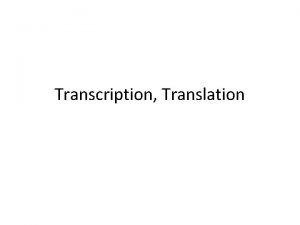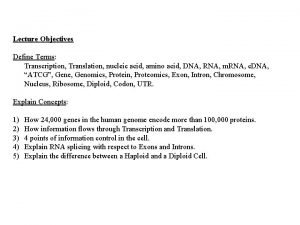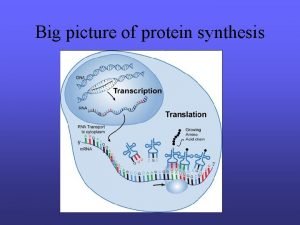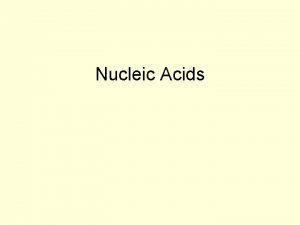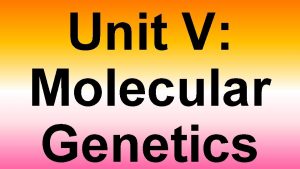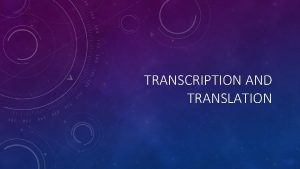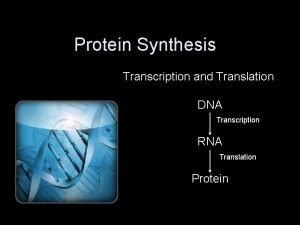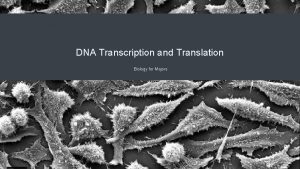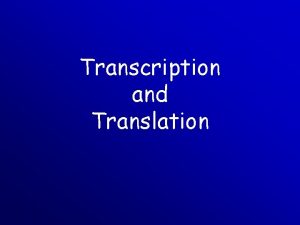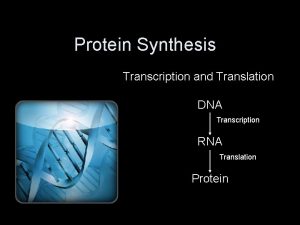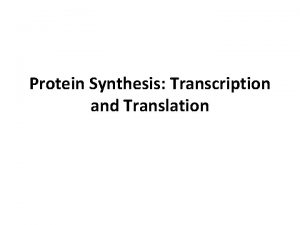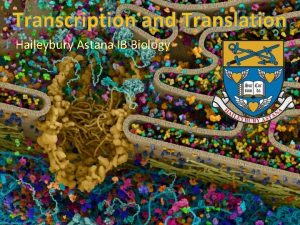Transcriptio n and Translation Transcription and Translation 0










- Slides: 10

Transcriptio n and Translation

Transcription and Translation 0 Gene- a section of DNA that codes for a protein. 0 Genes have three parts: promoter, coding region, and termination site (stop codon). 0 Transcription and translation both have three steps: initiation, elongation, and termination.

Transcription 0 The process of making a m. RNA strand from a DNA template using base pairing rules. Occurs in the nucleus. 0 Initiation- RNA polymerase binds to the promoter. 0 Elongation- RNA polymerase makes a copy of the coding region using base pairing rules. The bond that forms between adjacent RNA nucleotides is a phosphodiester bond. 0 Termination- RNA polymerase makes m. RNA until it reaches the termination site where it stops.

m. RNA Processing 0 G-capping: a methylated guanine is added to the 5’ end of the m. RNA, this cap acts as a signal to allow the m. RNA to exit the nucleus. 0 Poly- A tail: A tail made of many adenines is added to the 3’ end of the m. RNA. This tail protects the 3’ end of the m. RNA from being degraded. 0 Intron Removal: Introns are sections of the message that do not contain code for the desired protein. Exons are sections that do contain the code. Introns must be removed to translate the correct protein.

Translation 0 The process of making a protein from a m. RNA message. Uses (transfer) t. RNA as a translator to convert the nucleic acid message into the amino acid sequence. Occurs in the cytoplasm. 0 Initiation- The ribosome binds to the start codon (AUG) and begins translation. 0 Elongation- The ribosome elongates the amino acid chain each time a t. RNA base pairs a new anti-codon to the m. RNA codons. The growing polypeptide is removed from the P site t. RNA and attached to the amino acid in the A site t. RNA. The bond that is formed between adjacent amino acids is a peptide bond. 0 Termination- Once the ribosome reaches the stop codon (UAG, UAA, UGA) the ribosome terminates translation and the protein is released into the cytoplasm.

Marshall Nirenberg cracked the code that Francis Crick discovered in the central dogma. Nirenberg allowed us to decode the nucleic acid to protein message and begin to understand the structure and function of genes and proteins. Nirenberg discovered 64 codons that code for 20 amino acids. This means that the genetic code is degenerate, meaning that some amino acids are coded for my multiple codons.

Practice- Transcription and Translation 0 0 DNA m. RNA t. RNA Protein TAC GGC TAC TCC CGC ATA GAT 0 0 DNA m. RNA t. RNA Protein TAC AAT GTT CAG GGT CGA AAG

Mutations 0 Substitution (point mutations)- 0 Frameshift- a mutation that results in the exchange of one base for a shift in the codon reading frame. another. CGT→ CAT 0 Insertions- Addition of 1 of more 0 Missense- codes for a different amino acid 0 Nonsense- codes for a stop codon 0 Silent- codes for the same amino acid using a different codon nucleotides. Shifts the reading frame downstream 0 Deletion- Deletion of one or more nucleotides. Shifts the reading frame upstream 0 Large Scale Mutations- whole chunks of 0 Wobble- Substitutions in the 1 st the chromosome can be inverted, duplicated, inserted, and deleted which codon position are the most usually has a drastic affect on the dangerous. Because of a organism. This also can benefit the phenomena called wobble organism and drive human evolution as substitutions in the 2 nd is less shown by the duplications of hemoglobin dangerous and in the third genes and by the fusion of chimp position is the least dangerous. chromosome 2 p and 2 q into the human This is a result of the chromosome 2. degenerate genetic code.

Practice- Identify the type of Mutation 0 Wild type DNA TAC GGC TAC TCC CGC ATA GAT 0 Mutant DNA TAC GGC GAC TCC CGC ATA GAT 0 Mutant m. RNA 0 Mutant t. RNA 0 Mutant Protein 0 Wild type DNA TAC AAT GTT CAG GGT CGA AAG 0 Mutant DNA TAC AAT GTT CAG TGG TCG AAA 0 Mutant m. RNA 0 Mutant t. RNA 0 Mutant Protein

Links https: //www. youtube. com/watch? v=itsb 2 Sq. R-R 0 https: //www. youtube. com/watch? v=Wsof. H 466 lqk https: //www. youtube. com/watch? v=z. FVH 9 Sqt. JCM https: //www. youtube. com/watch? v=Yj. Wu. Vrzv. ZYA https: //www. youtube. com/watch? v=5 b. LEDd-PSTQ https: //www. youtube. com/watch? v=FN 9 JA-Epuj. E https: //www. youtube. com/watch? v=qx. XRKVomp. I 8 http: //www. pbs. org/wgbh/aso/tryit/dna/shockwave. html http: //users. rcn. com/jkimball. ma. ultranet/Biology. Pages/M /Mutations. html http: //evolution. berkeley. edu/evolibrary/article/mutations _03 http: //www. evolutionpages. com/chromosome_2. htm
 ترجمه0
ترجمه0 Transcription and translation coloring
Transcription and translation coloring Perbedaan replikasi virus dna dan rna
Perbedaan replikasi virus dna dan rna Complete the following venn diagram
Complete the following venn diagram Protein synthesis bbc bitesize
Protein synthesis bbc bitesize Dna transcription and translation
Dna transcription and translation Dna replication transcription and translation
Dna replication transcription and translation Translation biology
Translation biology Picture transcription
Picture transcription Transcription and translation
Transcription and translation Biology transcription and translation
Biology transcription and translation

